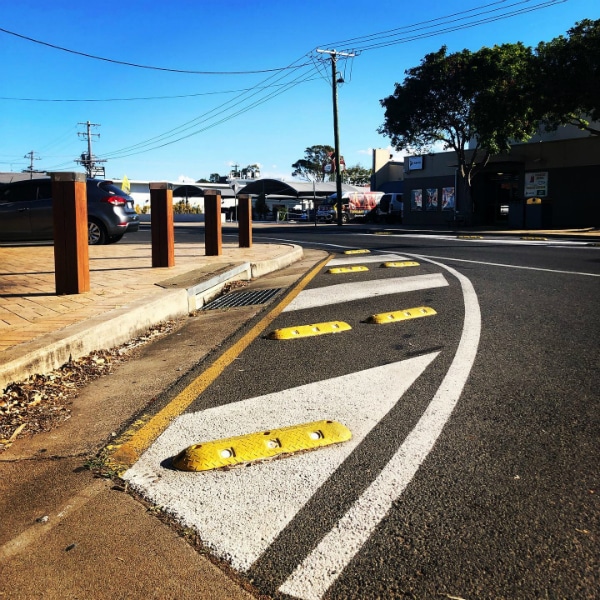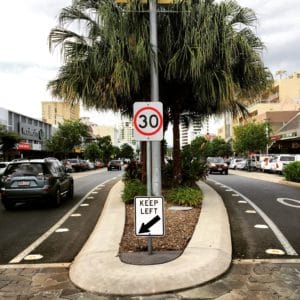

A traffic calming project is usually designed to reduce and minimise the risks posed by vehicles, particularly in built up areas. It involves implementing design features and strategies to reduce traffic speed and volume and provide more space for pedestrians and cyclists. A traffic calming project can be something as simple as minor modifications on a specific street to a more comprehensive engineering redesign of a road network.
According to the Centre For Accident Research and Road Safety, there are a number of engineering interventions that have proven effective in improving pedestrian safety. These include:
Australian road engineers use a number of traffic calming measures to slow down or reduce traffic to improve the safety of all motorists, pedestrians and cyclists. Some of the most common physical means include roundabouts, chicanes, speed humps, rumble bars and lane dividers.
The following measures are designed to slow cars to anywhere between 10 and 40 km/h. In the past traffic calming devices were traditionally constructed from asphalt or concrete but today many products are made of rubber for a safer, more modern alternative.
Speed Humps: Small and effective speed reducers, usually used for very low-speed areas like carparks. They are rounded and spans the width of the road, used on residential streets.
Speed Cushions: Two or three speed humps placed in a line across the road.
Speed Tables: A wide speed hump with a flat top, typically used in residential areas and for pedestrian crossings.
Chicanes: Requires drivers to negotiate road build outs in residential streets and give way to opposing traffic.
Rumble Bars: Alerts drivers to approaching intersections, crossing shoulder, centreline and lane departure areas.
Lane Dividers: Help to delineate lanes and roundabouts.
Bollards: Used to identify hazards and separate pedestrians from traffic movement.
Another effective means of traffic calming is road narrowing which enforces a natural reduction in speed. Visual cues, such as roadside planter boxes, bike lanes and on-street parking, signal drivers to slow down and pay more attention, thereby reducing the likelihood of crashing and causing injury to other motorists, cyclists and pedestrians. Often roading engineers add a brick coloured overlay to roads as a visual indication of high traffic areas. A vehicle activated sign with a ‘slow down’ appearing is a common visual way to get the message across.
The narrowing of roads can be achieved by several methods, including extending the footpath, curb extensions and chokers, which narrow the road to a single lane at vital safety points like pedestrian crossings. Removing a lane from a busy road, known as ‘road dieting’, also reduces traffic speed, as do pedestrian islands in the middle of the road and adding parking on one or both sides of the road.
Some high-risk areas where traffic calming measures are essential are residential areas, schools, hospitals and well-known crash spots. When creating traffic calming plans, roading engineers don’t just think about the physical measures or visual cues they need to put in place. Public education on driver behaviour and police enforcement are also necessary components for successful traffic calming.
When it comes to speed humps, rumble bars and wheel stops, get in touch with Speed Humps Australia today, and we can help create a solution for you.
Disclaimer: Data in this article was obtained from the sources named below from the latest available data as at June 2020. Speed Humps Australia does not guarantee the accuracy or completeness of the data and accepts no liability whatsoever arising from or connected in any way to the use or reliance upon this data.
https://research.qut.edu.au/carrsq/wp-content/uploads/sites/296/2020/12/Pedestrian-Safety.pdf
https://www.bitre.gov.au/statistics/safety/
https://www.bitre.gov.au/sites/default/files/Road%20trauma%20Australia%202018%20statistical%20summary.pdf



For 10 years, our focus has been on one thing: to provide one style of product and to do it well.
Our wheel stops, speed humps and rumble bars meet Australian Standards, don’t fade, and we’ve never needed to replace one.

For 10 years, our focus has been on one thing: to provide one style of product and to do it well.
Our wheel stops, speed humps and rumble bars meet Australian Standards, don’t fade, and we’ve never needed to replace one.